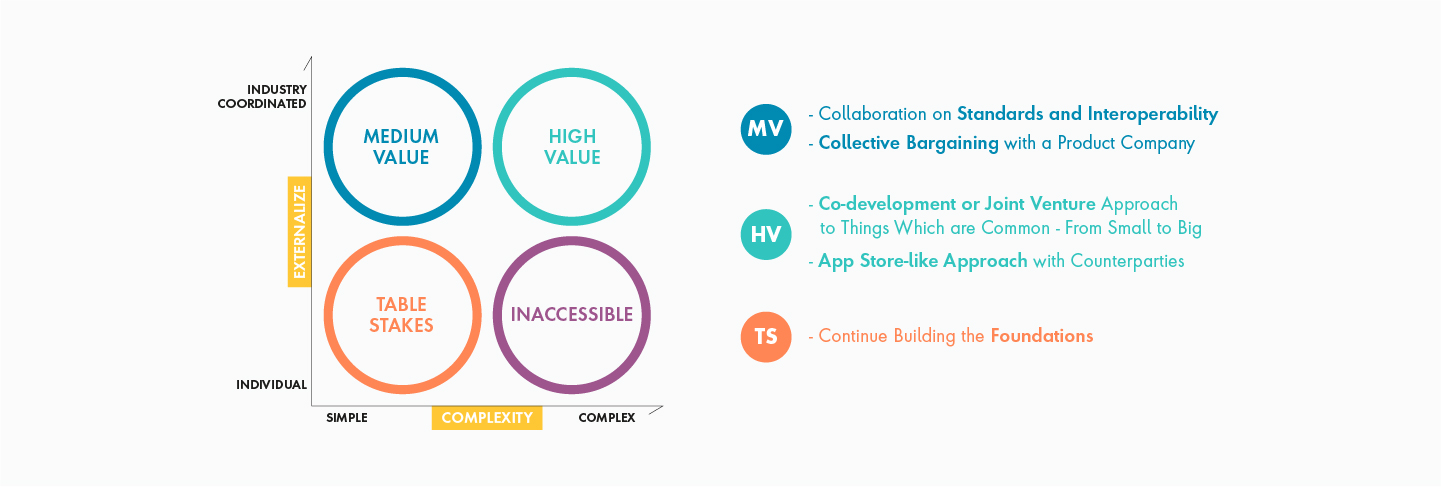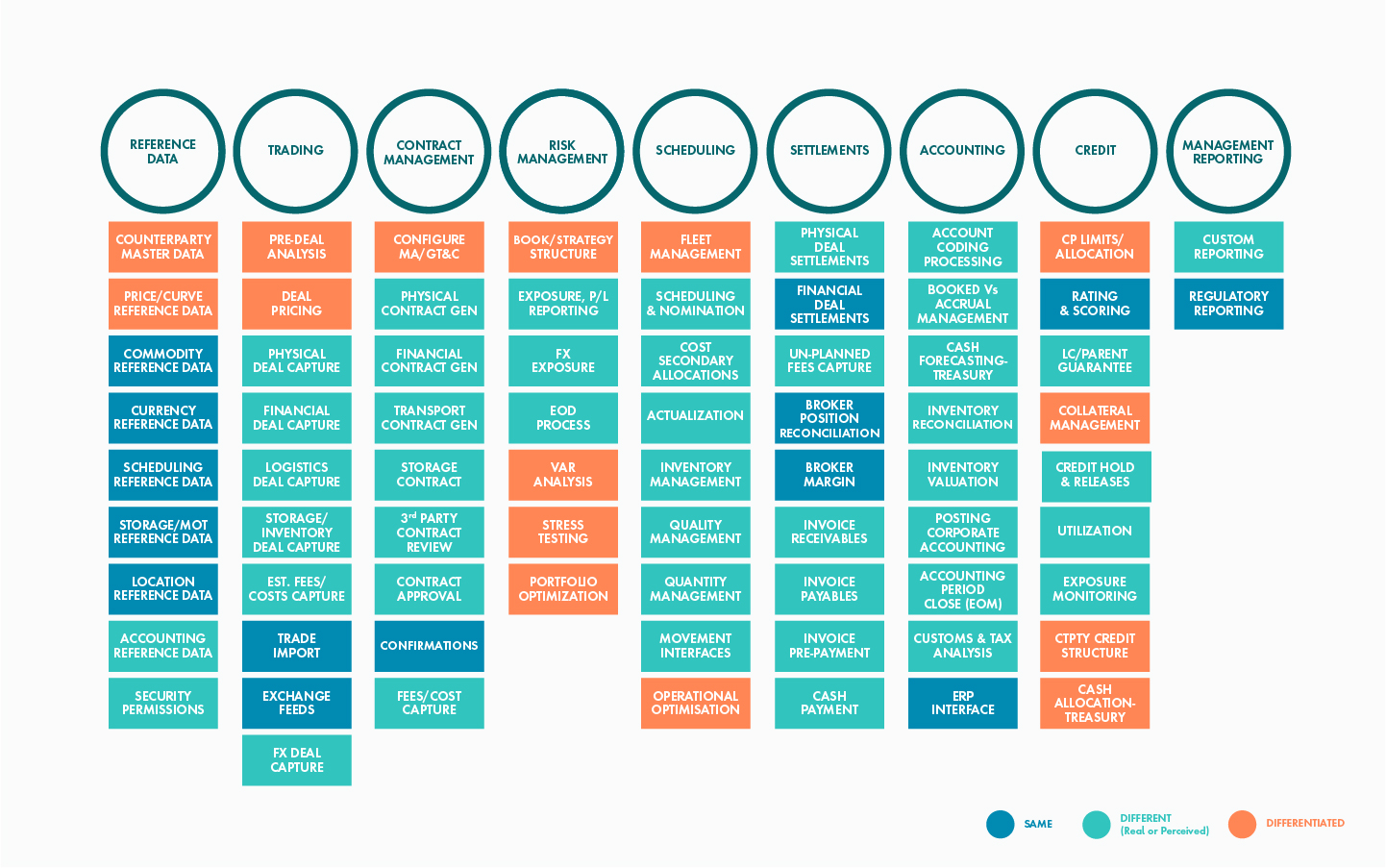What issue can we solve for you?
Type in your prompt above or try one of these suggestions
Suggested Prompt



Energy & Commodities
Energy Traders Are Missing a Major Opportunity
Energy Traders Are Missing a Major Opportunity
Big gains are within reach if companies come together and collaborate to realize common answers to shared technology and business challenges.
In a post-Covid period of accelerated change, where patterns of energy use are shifting and countries are pushing the energy transition agenda, companies need to become more agile. This requires IT systems that are quicker and cheaper to adapt to the new environment along with a new approach to technology development based on collaboration with industry peers in areas of common interest.
Energy companies are taking important steps to update their technology already. They are investing in the essential foundations of a modern architecture: migrating to the Cloud and switching to SaaS, platform and data services.
Though crucial, these are just the “standard-issue” cost reduction and efficiency enablers that everyone is deploying. They confer no sustainable competitive advantage. Beyond them, however, lies another opportunity that the industry is currently missing – one that offers huge potential gains if energy companies are prepared to change the way they think about their IT needs and challenges.
The answer, in a word, is collaboration. This is not an idea that gets much airtime in energy trading today – but it should. Although energy companies might believe they have a lot of proprietary IP tied up in their energy trading and risk management systems, in reality there is far less than they think.
Many of the operations they perform and the tools they use are undifferentiated with no unique competitive edge. These companies have a lot more in common than they might realize and share many of the same IT challenges – collaborating to tackle them and achieve common standards in areas where it makes sense could deliver major upsides for everyone.
Many of the operations they perform and the tools they use are undifferentiated with no unique competitive edge. These companies have a lot more in common than they might realize and share many of the same IT challenges.
Ultimately, following this path would lead companies to break up their Energy Trading and Risk Management (ETRM) monoliths and differentiate more clearly between activities that create defensible competitive advantages and should therefore be proprietary, and those that are standard across the industry and should be provided as commoditized services to capture economies of scale. The goal should be to create “systems of analysis” as opposed to today’s “systems of record” – transitioning from a system that simply records core data to one that enables real-time analysis of core data to meet rapidly changing business needs.

The key is to change attitudes
Collaboration between energy trading companies is rare – VAKT Holdings, the venture set up by several players to develop post-trade processing solutions using blockchain, is a notable exception that proves the rule. Nevertheless, more widespread collaboration is possible.
Adopting the model proposed by technology strategist Simon Wardley, evolving a product into a commodity requires several conditions to be met. “Let us consider the evolution of an act from a product to a commodity. In order to achieve this, a number of conditions need to be met. The concept of providing the act as a commodity must exist. The technology to achieve this must be available. The act must be suitably well defined and widespread. Finally, you need a willingness or attitude amongst consumers to adopt a new model. The latter part is normally represented by dissatisfaction with existing arrangement eg. the constant consumer complaint that “this product is costly”.
“The big deficit is “attitude” – the willingness of industry players to engage in the process, remove barriers and create the partnerships that will be needed.”
Simon Wardley
First, the concept (and associated business case) needs to make sense. Then the digital capabilities required to make it happen need to be readily available. Many energy trading activities are suitable for commoditization since they are relatively standardized across the industry. The big deficit is in what Wardley terms “attitude” – the willingness of industry players to engage in the process, remove barriers and create the partnerships that will be needed.
Ways to frame the opportunity
Accepting that the conditions exist for collaboration to begin – if companies are open to its possibilities – the question then arises of how they might collaborate and where these efforts could have the greatest impact.

Conceptually, we see two key areas. Medium-value opportunities to address relatively simple problems or situations include collaboration on standards and interoperability of systems, as well as collective bargaining with software providers on tools that will be widely deployed. High-value opportunities to collaborate might include joint development projects on more complex activities and even the creation of apps and software tools that are sold across the industry via an “app store” approach.
In this context, Octopus Energy in the U.K. offers a clear example of what forward-thinking companies can achieve. Through its Kraken platform, Octopus has developed a Cloud-based microservice architecture to support its industry-leading customer service proposition. It is now licensing this CRM technology to other energy distributors around the world, creating a meaningful additional revenue stream while also driving standardization.
In terms of the effect on energy trading companies’ digital capabilities, we see collaboration as highly relevant to their efforts to become more agile and adapt more quickly to the changing environment.

The focus of this collaborative activity therefore sits between investment in their digital foundations on one hand – Cloud migration and adoption of SaaS-based models – and proprietary initiatives to increase revenues and develop differentiated service propositions, on the other.
Where do the biggest gains exist?
Which areas does it make most sense to consider first for collaborative efforts? Within the set of activities that all energy trading companies undertake in the normal course of business, only a few are clear sources of differentiation. Some are virtually identical from one company to the next while the largest group differs between companies, but this may be due simply to cultural or historical reasons rather than out of any business necessity.

A good place to initiate the collaborative journey is with reference data: it is uniform and largely standardized, yet every company has its own set of solutions for it. The other important reason to start with reference data is that it is easy to test and learn the technology solution and therefore to establish ways of working among a group of companies.
Similarly, companies could come together to develop a set of standard adapters to import real-time trade and pricing information from exchanges, as well as shared apps to do position calculations or provide smart reconciliation services to replace what are currently time-consuming, manual processes. Common industry platforms could be created for a range of other post-trade and settlement processes.
Achieving these advances would be relatively straightforward and would bring significant additional gains. Having real-time or streaming data on trading positions, for example, can fuel use cases further along the line such as algo or high-frequency trading. Especially where there are overlaps in the technology stack (e.g. a common Cloud provider and big data toolset) the economies of scale can be significant.

The barriers are not as high as you think
The barriers to progress in collaboration are often seen as too high to overcome. Forums for initiatives such as interoperability and common standards do not currently exist. It will take a change of attitudes to create them. Financial services provide an interesting point of reference – cross-industry interoperability initiatives kicked off just over a decade ago in the trading space, while Open Banking rounded off the wave of integration and disintermediation for the consumer side.
The potential gains are large. Companies that decide to embrace the idea of collaboration are likely to emerge stronger because they will gain the collective capacity to innovate quickly and on a scale they could not afford individually. The process will become easier, for example, for companies that are already working on the same Cloud platform and therefore using common solutions. There are different ways to structure collaborations – joint ventures are one avenue but not the only one. Companies might instead choose to commission development work jointly to an agreed specification. Options exist and are available now.

What energy trading companies are likely to need, however, is expert consulting input to help identify suitable use cases and facilitate the discussions between potential partners. The process requires an understanding that there will be nuances in the way each company wants to implement any solution, and that they will also demand a result that is flexible and future-proof.
The resulting balance of internal investments on the foundations and value-adding activities that deploy best-in-class solutions, and collaboration will provide the best springboard for energy companies to capture the opportunities of the radical transformation they are already going through.

Taking the collaboration route requires energy trading companies to adopt a new way of thinking. It might sound like a tall order, but the gains on offer are too big to ignore.
Related Reading
-
![The Transformation Roadmap for Energy Trading Organizations]()
The Transformation Roadmap for Energy Trading Organizations
Digital transformation is a journey. Organizations can find their way forward by investing in efficiency, agility and growth.
-
![]()
The Cloud Advantage
Moving to the cloud can be an efficient game changer for energy companies, but it requires careful consideration to make the most of it.
-
![]()
Grow from the Inside Out
To thrive, energy trading companies must embrace a tech-driven identity to attract top talent and embrace digital ways of working







